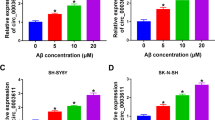Abstract
Alzheimer’s disease (AD) is a progressive neurodegenerative disease, characterized by Amyloid-β accumulation-induced neuronal injury. Emerging evidence shows that circular RNA (circRNA) is involved in AD development. The aim of this study was to illustrate the role of circ-HUWE1 in Amyloid-β accumulation-induced neuronal injury. Quantitative real-time PCR (qPCR) or western blot was conducted for the expression analysis of circ-HUWE1, miR-433-3p, and fibroblast growth factor 7 (FGF7). In functional assays, cell viability was determined by CCK-8 assay, and cell apoptosis was examined by flow cytometry assay, the protein levels of apoptosis-related markers, and caspase1 or caspase3 activity. The release of pro-inflammatory factors was monitored by ELISA. The predicted binding relationship between miR-433-3p and circ-HUWE1 or FGF7 was validated by dual-luciferase reporter assay. We discovered that circ-HUWE1 absence alleviated Amyloid-β-induced cell viability degradation, cell apoptosis, and inflammatory responses in SK-N-SH cells. MiR-433-3p was a target of circ-HUWE1, and miR-433-3p inhibition reversed the effects of circ-HUWE1 knockdown. In addition, FGF7 was a downstream target of miR-433-3p whose function could be abolished by FGF7 reintroduction. Circ-HUWE1 positively regulated FGF7 expression via competitively targeting miR-433-3p. Moreover, circ-HUWE1 knockdown activated the WNT signaling pathway in Amyloid-β-treated SK-N-SH cells by targeting the miR-433-3p/FGF7 axis. In conclusion, circ-HUWE1 knockdown alleviates Amyloid-β-induced neuronal injury in SK-N-SH cells via miR-433-3p release-mediated FGF7 depletion.







Similar content being viewed by others
Data Availability
Data sharing not applicable to this article as no datasets were generated or analyzed during the current study.
References
Akhter R (2018) Circular RNA and Alzheimer’s disease. Adv Exp Med Biol 1087:239–243
Chen W et al (2020) MicroRNA-107 aameliorates damage in a cell model of Alzheimer’s disease by mediating the FGF7/FGFR2/PI3K/Akt pathway. J Mol Neurosci 70(10):1589–1597
De Ferrari GV et al (2014) Wnt/beta-catenin signaling in Alzheimer’s disease. CNS Neurol Disord Drug Targets 13(5):745–754
DeTure MA, Dickson DW (2019) The neuropathological diagnosis of Alzheimer’s disease. Mol Neurodegener 14(1):32
Janota C, Lemere CA, Brito MA (2016) Dissecting the contribution of vascular alterations and aging to Alzheimer’s disease. Mol Neurobiol 53(6):3793–3811
Jia L, Pina-Crespo J, Li Y (2019) Restoring Wnt/beta-catenin signaling is a promising therapeutic strategy for Alzheimer’s disease. Mol Brain 12(1):104
Ke S et al (2019) Long Noncoding RNA NEAT1 aggravates abeta-induced neuronal damage by targeting miR-107 in Alzheimer’s disease. Yonsei Med J 60(7):640–650
Li Y et al (2020) Circular RNA expression profile of Alzheimer’s disease and its clinical significance as biomarkers for the disease risk and progression. Int J Biochem Cell Biol 123:105747
Liu L et al (2014) Dysfunctional Wnt/beta-catenin signaling contributes to blood-brain barrier breakdown in Alzheimer’s disease. Neurochem Int 75:19–25
Liu L et al (2020) Identification of circular RNA hsa_Circ_0003391 in peripheral blood is potentially associated with Alzheimer’s disease. Front Aging Neurosci 12:601965
Long JM, Holtzman DM (2019) Alzheimer disease: an update on pathobiology and treatment strategies. Cell 179(2):312–339
Masters CL et al (2015) Alzheimer’s Disease Nat Rev Dis Primers 1:15056
McKhann GM et al (2011) The diagnosis of dementia due to Alzheimer’s disease: recommendations from the National Institute on Aging-Alzheimer’s Association workgroups on diagnostic guidelines for Alzheimer’s disease. Alzheimers Dement 7(3):263–269
Schonrock N, Gotz J (2012) Decoding the non-coding RNAs in Alzheimer’s disease. Cell Mol Life Sci 69(21):3543–3559
Tan L et al (2013) Non-coding RNAs in Alzheimer’s disease. Mol Neurobiol 47(1):382–393
Tiwari SK et al (2015) Ethosuximide induces hippocampal neurogenesis and reverses cognitive deficits in an amyloid-beta toxin-induced Alzheimer rat model via the phosphatidylinositol 3-kinase (PI3K)/Akt/Wnt/beta-catenin pathway. J Biol Chem 290(47):28540–28558
Treiber T, Treiber N, Meister G (2012) Regulation of microRNA biogenesis and function. Thromb Haemost 107(4):605–610
Wang R, Zhang J (2020) Clinical significance of miR-433 in the diagnosis of Alzheimer’s disease and its effect on Abeta-induced neurotoxicity by regulating JAK2. Exp Gerontol 141:111080
Xin Z et al (2017) The understanding of circular RNAs as special triggers in carcinogenesis. Brief Funct Genomics 16(2):80–86
Xu SC et al (2012) Association between fibroblast growth factor 7 and the risk of chronic obstructive pulmonary disease. Acta Pharmacol Sin 33(8):998–1003
Yang H et al (2019) Circular RNA circ_0000950 promotes neuron apoptosis, suppresses neurite outgrowth and elevates inflammatory cytokines levels via directly sponging miR-103 in Alzheimer’s disease. Cell Cycle 18(18):2197–2214
Zhang N et al (2020) Berberine attenuates Abeta42-induced neuronal damage through regulating circHDAC9/miR-142-5p axis in human neuronal cells. Life Sci 252:117637
Zhou C et al (2019) Mir-455-3p-1 represses FGF7 expression to inhibit pulmonary arterial hypertension through inhibiting the RAS/ERK signaling pathway. J Mol Cell Cardiol 130:23–35
Funding
This work was supported by the Basic Research and Exploration of Yuzhong District, Chongqing (No. 20200143).
Author information
Authors and Affiliations
Contributions
Yalan Chen and Pei Wang designed and performed the research; Liu Yang and Chenggang Li analyzed the data; Tao Meng wrote the manuscript. All authors read and approved the final manuscript.
Corresponding authors
Ethics declarations
Ethics Approval and Consent to Participate
Written informed consents were obtained from all participants, and this study was permitted by the Ethics Committee of Chongqing University Central Hospital. NO. C20200108. The research has been carried out in accordance with the World Medical Association Declaration of Helsinki, and that all subjects provided written informed consent.
Consent for publication
Not applicable.
Conflict of interest
The authors declare no competing interests.
Additional information
Publisher's Note
Springer Nature remains neutral with regard to jurisdictional claims in published maps and institutional affiliations.
Supplementary Information
Below is the link to the electronic supplementary material.
Rights and permissions
About this article
Cite this article
Meng, T., Chen, Y., Wang, P. et al. Circ-HUWE1 Knockdown Alleviates Amyloid-β-Induced Neuronal Injury in SK-N-SH Cells via miR-433-3p Release-Mediated FGF7 Downregulation. Neurotox Res 40, 913–924 (2022). https://doi.org/10.1007/s12640-022-00523-5
Received:
Revised:
Accepted:
Published:
Issue Date:
DOI: https://doi.org/10.1007/s12640-022-00523-5




